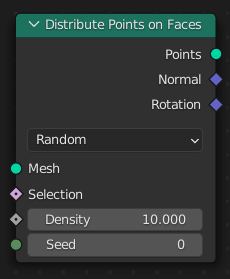分布点于面上

The Distribute Points on Faces node places points on the surface of the input geometry object. Point, corner and polygon attributes of the input geometry are transferred to the generated points. That includes vertex weights and UV maps. Additionally, the node has Normal and Rotation outputs.
节点也会产生一个稳定的ID,存储在内置的 id 属性中,作为每个点的稳定标识。当网格变形或密度改变时,每个剩余的点的数值将是一致的。这个属性在 随机值 和 点上的实例 节点中使用。
输入
- 几何数据
标准的几何图形输入。
Note
输入的几何体必须包含一个带面的网格。
- 选择
选择哪些面的角应该被考虑用于点的分布。
- 最小距离
点与点之间可以有的最小距离。这个选项只适用于 泊松磁盘 分布方法。在其默认值为0时,节点的行为与 随机 模式下的行为相同,因为内部生成的点都不会被移除。
- 密度最大
点分布的点密度。单位是每平方米的点数。这个值要乘以 密度 输入的值。只在 泊松盘 模式下可用。
Note
这将由*Distance Min*选项对分布进行封顶。如果密度大于最小距离所允许的范围,那么在超过这个阈值后,将不会有新的点被添加。
- 密度
在每个网格面上每平方米要分布的点数。这个数值乘以 密度属性 的数值。
在 泊松磁盘 模式下,该值乘以 密度最大值 输入,以获得最终密度。
- 随机种
生成点时使用的 随机种。
属性
- 分布方法
- 随机
在表面上随机分布点。这是最快的分发方法。
- 泊松盘
Distribute points randomly on the surface while taking a minimum distance into account.
输出
- 点
生成的点。命名的属性会和其他属性字段输出的数据一起被复制到结果网格。
- 法向
法线 的三角形,每个点都散布在这个三角形上。
- Rotation:
An XYZ Euler rotation built from the normal attribute for convenience. Such a value can also be built from the normal with the 旋转欧拉. Keep in mind that the Z axis of the result rotation will be arbitrary, since the mesh normal used to create the rotation does not have enough information to set all three rotation axes.